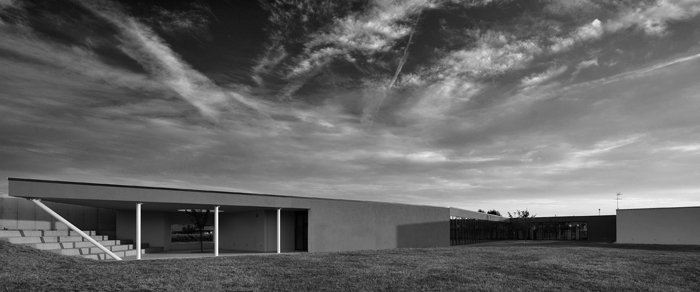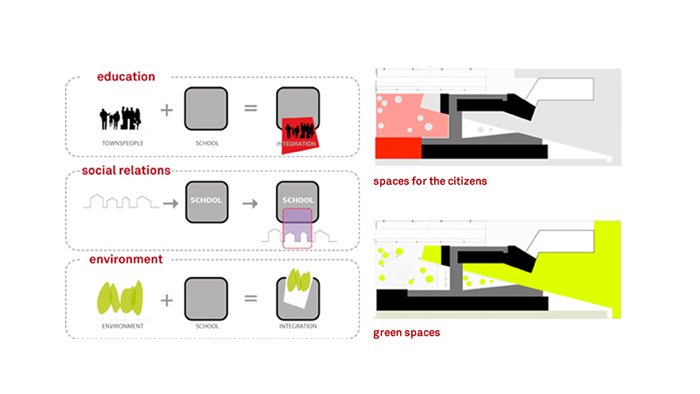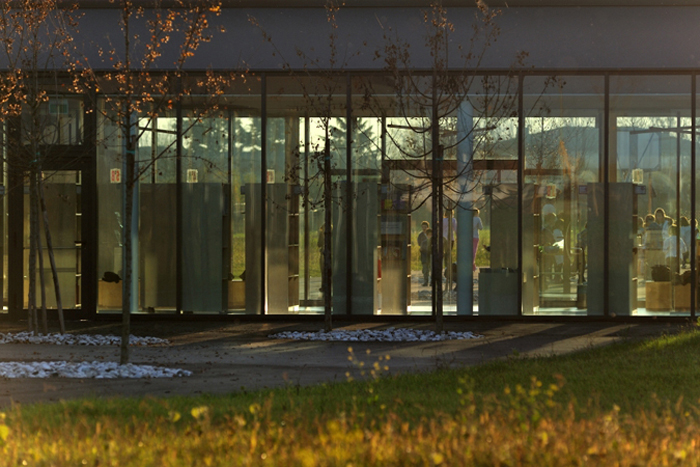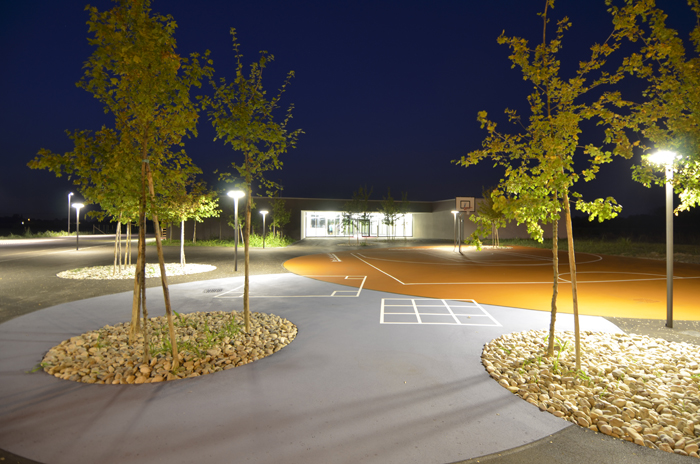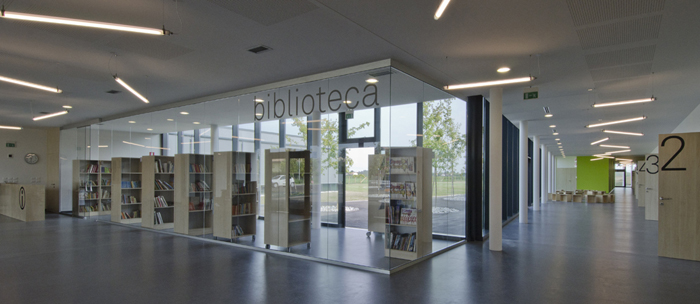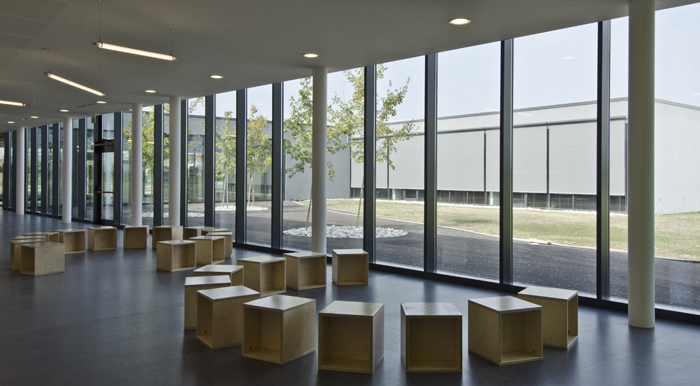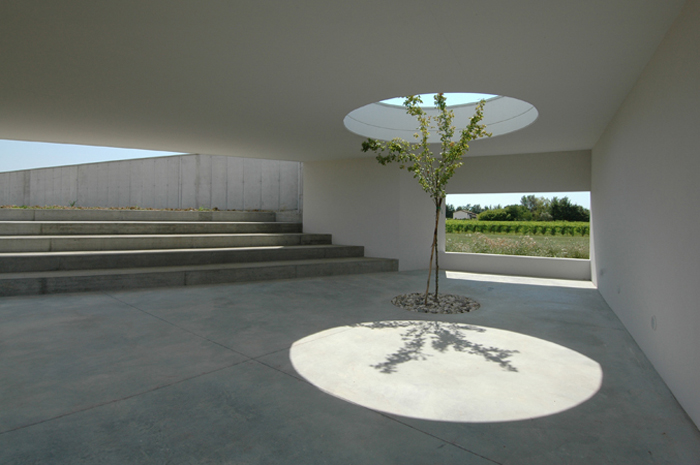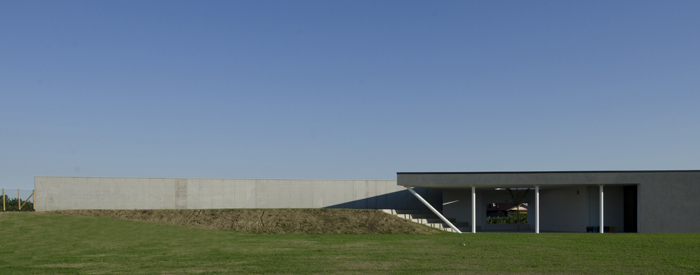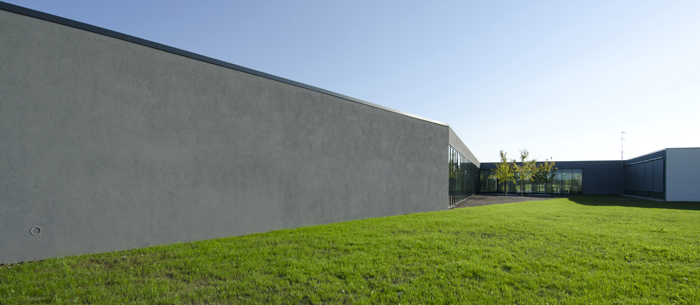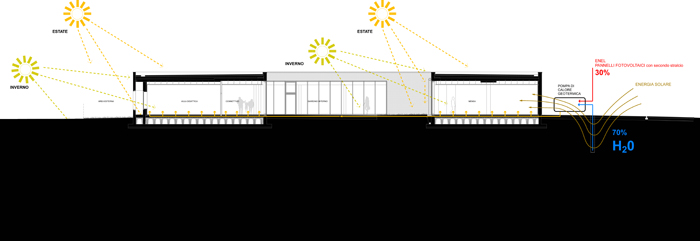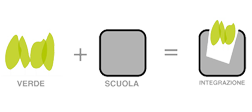The landscape makes the school.
The scholastic campus is composed of a complex organism: the new primary school, formed by 10 classrooms, teachers rooms, specialist rooms, computer rooms, library, and school canteen with relative service areas, (the gym and infants school will be in the second phase), the vegetable plots, civic areas and educational agricultural park.
The area destined for the new construction is composed of a totally free field space surrounded by areas destined for agricultural use.
Land settlement principles utilize the resources of the location as an element of quality for the school itself.
The planimetric distribution of the building was organized in such a way as to construct a strict physical/visual/functional relationship with the open spaces.
The disposition of the buildings, all single story, are arranged to intersect the view, the contact and the use of the open space both in relation to the possible educational-sporting activities of the school and in connection with the possibility of fruition for public activities outside the hours of those educational.
The perceptive/functional osmosis applied on various fronts optimizes the relationships with the exterior landscape (thus maintaining also the sense of belonging), to define the interaction between architecture and ‘nature’ (allowing the building construction to settle and find the right balance with the land outside), to qualify the visibility from the inside (giving an educational role to the perception as, for example, the confrontation between the different seasonal transformations), to improve the quality of environmental comfort (improvement of local micro-climate, sunshine management,….).
The recreation area outside the school, entrance square, was designed with the insertion of diversified play areas of interest such as the basketball zone, and ‘street games’ (posting on the ground of pavement games like tic-tac-toe, 4 cantons, hopscotch,….). This area represents the point of interest at the access of the school activity but is intended to be above all a meeting point and place for socialization by all those who use the school and available also for free utilization and occupation after school hours.
The building was modulated in the plans and orientated to best exploit solar radiation.
The 10 educational classrooms point to the east so as to find the best exposure and look out over the free communal area. The classrooms each measure 45 sq.mt. and have a wide aspect looking out towards the outside, and screened by vertical brise-soleil blinds that orientate the direct sunlight. Each classroom is fitted with an autonomous system for darkening.
The library is the access and distribution point, a place for receiving and welcoming and at the same time
relational, fulcrum of the scholastic mobility. It was decided to locate in this advanced position a place for reading books as a school presentation element and as a transit element permeable to be seen between the external spatiality and the more controlled internal spaces.
The connecting area between the different rooms is composed of a space that distends towards the garden; here the hygiene services, specialist activity rooms and a storage room are located.
The area limits of the school are characterized by an embankment (made with material from the excavation), a gentle slope, that going up allows for a direct vision of the agricultural landscape and the historical road, that itself represents a downward slope/amphitheater for educational activities, outside classroom, protected by a large flat covering and delimitated by an external wall in cement with a coarse untreated finish.
Approximately 70% of energy requirements is generated by a geothermic system originating from the water table, whilst the remaining 30% is sourced from the ENEL electrical power net.
The building is classified as energetic class A.
The adjacent area to the school measure approximately 10,000 sq. mt. and has been thought of for ‘field’ experience. The educational-agricultural park is organized to create moments of diverse activities in the open field, with accessibility and differentiated uses between users and maintenance and management actions. The usage themes of the proposed area allow for clear examples of ‘natural’ movements, cultural transformations, but also mutations of the vegetation, placing in parallel controlled spaces with those free to evolve themselves, dry areas, wet areas, production areas, observation zones, …
On the terrain adjacent to the new Sant’Elena school an ‘agricultural campus’ will rise up with the aim to:
+ reintroduce the typical elements of the local ecosystem;
+ plant fruit trees;
+ re-establish ditches and hedges;
+ realize a series of organic vegetable plots and short paths to walk along and stops for pause.
The formative proposal for the school:
+ dedicated days for the realization of the park: planting hedges, fruit trees; realization of paths; realization of vegetable plots;
+ a ‘school class vegetable plot’ – each class will have the possibility to follow and participate in every phase of the cultivation process of the vegetable plot from the preparation of the ground to the harvesting;
+ educational-environment trail integrated with the educational curriculum in science subjects;
+ project for integrated school time offering further educative activity to compliment and sustain the educational program in class;
+ small commercial project to sell the products cultivated by school students;
+ report cards;
+ provide new educative opportunities;
+ promote social integration/citizenship projects;
+ learning ‘by doing’;
+ work internships;
+ home education projects for minors;
+ free-time management projects for physically and mentally challenged people;
+ evening courses for the townspeople;
+ awareness days, and festivals themed on social agriculture open to families;
+ sustaining situations of fragility.
Crediti
Chronology | april 2011 – july 2012
Location | Via Pozzetto, Sant’Elena di Silea, Tv
Client | Immobilmarca srl
Project | MADE associati _ Treviso
arch. Michela De Poli
arch. Adriano Marangon
Coll. | arch. Monica Martini
Contractor | CARRON Costruzioni Generali
Structural project | Studio Toso Riccio Ingegneria
Installations | Ing. Stefano Melato
Acustic | PRO.TECNO s.r.l.
Plumbing project | iDeVa Ingegneria
Lot area | 9.920 sq.mt. (school) +
10.000 sq.mt. (educational agricultural park)
Covered area | first phase 1.779 sq.mt.
Volume | 7.650 cu.mt.
Cost | Euro 2.189.989,25
Photo|Adriano Marangon, Michela De Poli, Corrado Piccoli
Link:
